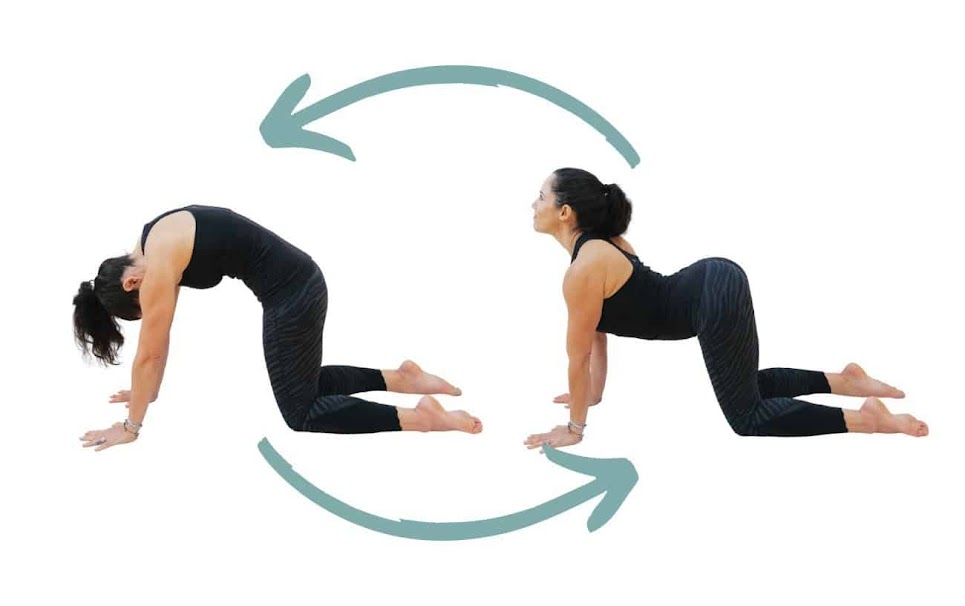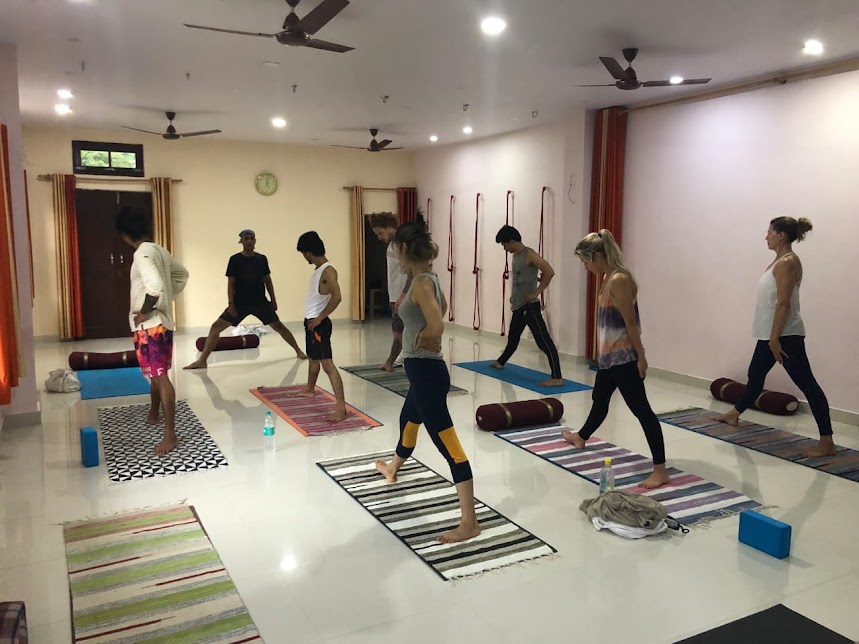YOGA FOR BEGINNER
Introduction to yoga
Yoga is a physical, mental, and spiritual discipline that originated in ancient India. The word "yoga" comes from the Sanskrit word "yuj," which means "to yoke," or "to unite." In the context of yoga, this refers to the union of the individual self with the universal consciousness, or the divine.Yoga has been practiced for over 5,000 years, and has a rich history and tradition. It was originally passed down orally from teacher to student, and was later written down in the form of scriptures, such as the Yoga Sutras of Patanjali.
 |
Ravinder yoga school. Yoga teacher training courses in Rishikesh, India.
|
In modern times, yoga has become popular as a form of physical exercise, as well as a way to improve mental and spiritual well-being. It is typically practiced by performing a series of physical poses, or "asanas," which are combined with breath control, meditation, and relaxation techniques.The physical poses of yoga help to improve flexibility, strength, and balance, and can also help to reduce stress and improve overall physical health. The breath control and meditation techniques can help to calm the mind and improve mental clarity, and the relaxation techniques can help to reduce anxiety and improve sleep.
Overall, the goal of yoga is to promote physical and mental well-being, and to facilitate personal growth and self-realization. It is a holistic practice that can benefit the body, mind, and spirit.
Benfits of Yoga
Improved flexibility: Yoga involves stretching and holding various poses, which can help to increase flexibility over time. Improved flexibility can help to reduce the risk of injury, and can also help to improve posture and overall physical function.
Improved strength: Many yoga poses require the use of body weight and gravity to build strength, particularly in the core, arms, and legs. Improved strength can help to improve physical performance and reduce the risk of injury in everyday life.
Improved balance: Yoga requires balance and stability, particularly in standing poses. Improved balance can help to reduce the risk of falls, and can also improve overall physical function.
Stress reduction: Yoga involves breath control, meditation, and relaxation techniques, which can help to reduce stress and anxiety. The physical poses and relaxation techniques can help to calm the mind, and the meditation techniques can help to improve focus and clarity.
Improved mental clarity: The breath control and meditation techniques of yoga can help to improve focus and clarity, and can also help to reduce the effects of stress and anxiety on the mind. Improved mental clarity can lead to better decision making and problem solving.
Overall, the physical, mental, and relaxation techniques of yoga can help to improve overall well-being by reducing stress and improving physical and mental function.

Hatha yoga: Hatha yoga is a general term that refers to any type of yoga that involves physical poses. Hatha yoga classes are typically slower-paced and more gentle, making them a good choice for beginners.
Vinyasa yoga: Vinyasa yoga, also known as flow yoga, involves a series of poses that are linked together in a flowing sequence. Vinyasa classes are typically more dynamic and fast-paced, and may include more challenging poses.
Ashtanga yoga: Ashtanga yoga is a more physically demanding style of yoga that involves a set series of poses that are performed in a specific order. Ashtanga classes are typically fast-paced and physically challenging, and may not be suitable for beginners.
Yin yoga: Yin yoga involves holding seated or supine poses for an extended period of time, with the aim of increasing flexibility and improving the flow of energy through the body. Yin classes are typically slower-paced and more meditative, and may be a good choice for beginners.
Overall, it's important to choose a yoga class that is suitable for your fitness level and goals. If you are new to yoga, it may be a good idea to start with a gentler, slower-paced class, such as Hatha or Yin yoga. As you become more comfortable with the practice, you can try more challenging styles, such as Vinyasa or Ashtanga.
Preparing for a yoga class:
What to wear: It's important to wear comfortable, breathable clothing that allows for a full range of movement. Avoid wearing clothing that is too loose or baggy, as it may get in the way during certain poses. It's also a good idea to remove any jewelry, as it may get in the way or cause discomfort during the practice.
What to bring: You will typically need to bring a yoga mat to class, as well as any other props that you may use, such as blocks or straps. Some studios may provide these items for you, so it's a good idea to check in advance. It's also a good idea to bring a water bottle and a towel, as you may sweat during the practice.
How to behave during class: It's important to be respectful of other students and the instructor during class. Arrive on time, and turn off any electronic devices to minimize distractions. Follow the instructor's instructions and cues, and modify or skip any poses that do not feel comfortable or safe for you. It's also a good idea to let the instructor know if you have any injuries or conditions that may affect your practice.
Yoga poses for beginners
Here are descriptions and illustrations of some basic yoga poses that are suitable for beginners:
Downward-facing dog pose
This pose, also known as "Adho Mukha Svanasana," is a great way to stretch the entire body. To perform the pose, start in a tabletop position with your hands and knees on the ground. Spread your fingers wide, and tuck your toes under. Lift your hips up and back, straightening your legs as much as possible. Press down into your hands and heels, and lift your sitting bones towards the ceiling. Hold the pose for a few breaths, then release and return to tabletop position.
Warrior 1 pose
This pose, also known as "Virabhadrasana I," is a great way to strengthen the legs and improve balance. To perform the pose, start in a standing position with your feet hip-width apart. Step your right foot back, and turn it out slightly. Bend your left knee, and reach your arms up overhead. Gaze up at your fingertips, and hold the pose for a few breaths. Then, release and return to standing position, and repeat on the other side.
Child's pose
 |
This pose, also known as "Balasana," is a great way to stretch the back and hips, and to relax and unwind. To perform the pose, start in a kneeling position with your feet together and your knees hip-width apart. Lower your hips back towards your heels, and stretch your arms out in front of you. Lay your chest on your thighs, and hold the pose for a few breaths. Then, release and return to kneeling position.
Mountain pose
This pose, also known as "Tadasana," is a great way to improve posture and balance. To perform the pose, start in a standing position with your feet together and your arms at your sides. Lift your toes and spread them wide, then press down firmly through the balls of your feet and the heels. Lift your chest and draw your shoulders down and back. Gaze forward, and hold the pose for a few breaths.
Cat-cow pose
This pose, also known as "Marjaryasana-Bitilasana," is a great way to stretch the spine and improve mobility. To perform the pose, start in a tabletop position with your hands and knees on the ground. Inhale as you arch your back and gaze up towards the ceiling (cow pose). Exhale as you round your back and tuck your chin towards your chest (cat pose). Continue to alternate between the two poses, moving with your breath.
Cobbler's pose
This pose, also known as "Baddha Konasana," is a great way to stretch the inner thighs and hips. To perform the pose, start in a seated position with the soles of your feet together and your knees pointing out to the sides. Use your hands to gently press down on your knees, or use blocks or blankets to support your legs if you are unable to reach the ground. Hold the pose for a few breaths, then release and return to seated position.
These are just a few basic yoga poses that are suitable for beginners. As you become more comfortable with the practice, you can try more advanced poses, such as plank or crow pose.
Incorporating yoga into daily life
Practicing at home: One of the great things about yoga is that it can be practiced almost anywhere, at any time. If you are just starting out, it may be helpful to take a few classes at a studio to get a feel for the practice and learn the proper alignment for each pose. Once you feel more comfortable, you can try practicing at home using online resources, such as videos or streaming services, or by following along with a book or DVD.
Setting aside time for meditation: Meditation is an integral part of the yoga practice, and it can have many benefits for the mind and body. Even if you don't have time for a full yoga practice, you can still set aside a few minutes each day for meditation. This could involve sitting in a quiet place and focusing on your breath, or using a guided meditation app or recording.
Incorporating yoga into your daily routine: You can also incorporate elements of the yoga practice into your daily routine, such as by taking a few minutes to do some deep breathing exercises or stretching before bed, or by incorporating mindful movement into your daily activities.
Overall, the key to incorporating yoga into your daily life is to find a practice that works for you, and to make it a part of your routine in a way that feels natural and sustainable. With time and consistent practice, you may find that the benefits of yoga become an integral part of your daily life.
BY
Ravinder Yoga School Yoga Alliance Registered School in Rishkesh, India Affordable Yoga Teacher Training in India.
|









.jpg)










Comments
Post a Comment